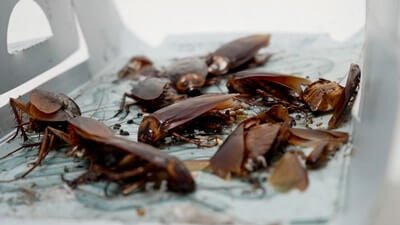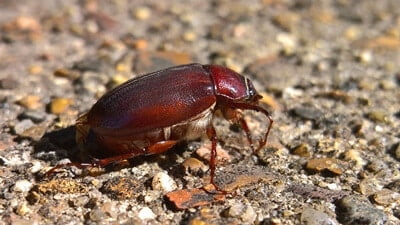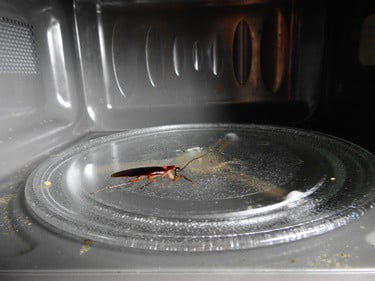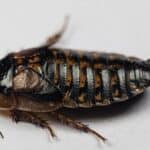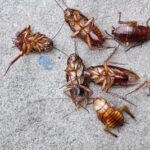Cockroaches are adept at hiding. They can tuck themselves into your walls, furniture, and even your electronics. Obviously, you can’t spray down your Xbox with a can of insecticide. You’ll need to get roaches to come out of hiding before you can properly exterminate them. That leaves you to come up with ways to tempt roaches into open view.
You can lure cockroaches out of hiding with sticky traps, bait, or DIY lures. Commercial bait traps are made of high-grade poison that has a tempting aroma. This lures out roaches that eat the bait, bring traces back to their colony, and then die. Sticky traps capture them as they walk across them, allowing you to dispose of them easily. DIY options include soda bottle traps, jar traps, anti-roach cookies, or duct tape traps.
The DIY options achieve the same basic goals but cost less money. However, they are not a wise choice if you’re dealing with a full-scale infestation. A large colony of roaches will need professional-grade insecticides to eliminate. All of these lures must be placed in strategic positions to get the best results.
How to Make Cockroaches Come Out of Hiding?
Cockroaches will not be tempted out of hiding easily. They know that they’re small, vulnerable, and surrounded by predators. If they feel threatened or crowded by people, they will stay put in their hiding spots.
As such, pounding on walls, shaking appliances, or jarring a mattress that’s infested with roaches won’t be very effective. The best way to draw out cockroaches is with a lure. To do this, you need to:
Pick The Right Lure
Roaches will only come out of hiding in search of food. Use their hunger against them. The most effective lures will be:
- Scented. Bait traps have a tempting artificial smell that draws roaches out of hiding.
- Mixed with food. Some traps require you to place your own bait, which is usually starch-heavy or sweet.
- Placed near food. If roaches are in your kitchen, place traps on their usual walking routes to catch them off guard.
Pick The Right Time
Roaches are nocturnal and will naturally come out of hiding during the nighttime hours. This is the best time to forage and breed without getting caught by predators. Don’t expect your traps to gain much attention in the daylight. They will mainly poison or capture the roaches at night.
Pick The Right Place
Once you’ve set the traps, leave the area clear and unattended. Cockroaches will stay in hiding when there is:
- Activity, such as people walking around
- Light, making it harder for the roaches to hide
- Noise, such as talking or music being played
Even if your bait is effectively set, you may find roaches avoiding it if you constantly check it. Pick the right location for your traps and let them be.
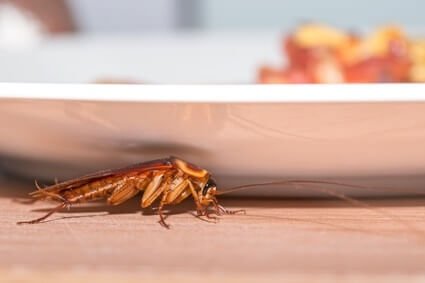
Best Ways To Draw Out Cockroaches
Here are the best professional lures to use when drawing out cockroaches.
Glue or Sticky Traps
Glue traps are a sheet of material with sticky adhesive spread across the top. These sticky traps capture roaches that walk across the material. Once their feet or underbellies come into contact with the glue, they’re unable to leave. This allows you to collect the traps and dispose of the roaches.
A study in Environmental Entomology compared 7 common sticky trap types. They found that these lures were effective in catching smaller nymphs or baby cockroaches. However, they struggled to hold larger ones.
Additionally, the set-up and design of the trap also impacted how many roaches were captured. For example, you can lay this trap flat or assemble it in a folded tent shape. In the study, the Trapper brand sticky trap caught more roaches when laid flat than assembled. However, the Mr. Sticky brand worked just as effectively in both positions.
This study concluded that the Victor-M330 sticky trap of the 7 that they tested was the best. It caught the most roaches. That’s because it worked in tandem with pheromones. The synthetically produced pheromone closely matched those produced in cockroaches naturally. It fooled the insects into believing that food and mates were present on the trap, luring them out from hiding.
Poisoned Bait
Most commercial roach traps work via a “lure and kill” method. This involves a piece of bait that’s coated in insecticide and pheromones designed to attract roaches. Once the roach ingests this poison, it will die. This poison is slow-acting so that the roach can return to its colony. When it dies there, other roaches will eat it and die as well.
This has the greatest impact on colonies. The Indian Journal of Medical Research studied imidacloprid gel, a common type of anti-cockroach bait. The application was able to reduce cockroach populations in a controlled setting by:
- 75-86.5% in 1 week
- 76-94% in 2 weeks
- 97-99% by the end of 8 weeks
The researchers noted that it’s important to reapply the bait. This ensures there’s enough bait to circulate throughout the entire roach colony. However, since this study was conducted in a controlled setting, there are other factors to consider. You may not be willing to live with the roaches for 8 weeks. You may also find pets or children investigating the traps set throughout your house.
According to the Journal of Economic Entomology, these traps are also more effective against smaller cockroach infestations than large ones. If you’re dealing with a full-scale roach problem, you may need stronger poisons. In this case, it’s better to contact an exterminator.
Combining Food With Traps And Bait
As mentioned, food works as the primary invitation for roaches in your home. Therefore, you can pair food with roach glue traps or bait to improve their effectiveness.
Bread
You can add rye bread crust to sticky traps or lace the crust with a cockroach bait. According to Entomologia Experimentalis et Applicata, this attracts the roaches from hiding more effectively than relying on the traps alone.
Bread is attractive to cockroaches because it’s high in starch. This keeps roaches satiated for longer. For that reason, cockroaches will sometimes feast on your books and wallpaper, which have starch in their glue.
Baby Food And Beer
According to Environmental Entomology, baby food jar traps were found to attract more adult cockroaches and larger nymphs than sticky traps. Baby food is high in calories and soft in texture, which roaches appreciate. To gain a similar effect, you can also dip bread in beer.
Peanut Butter And Grain
You can try peanut butter and distiller’s grain. The Journal of Economic Entomology conducted a study to evaluate how attractive certain traps and foods were to German cockroaches. It was discovered that peanut butter and distiller’s grain were even more effective than pheromone sticky traps.
Distiller’s grain can be found at some local markets. However, peanut butter is more readily available, making it your first option. You can combine peanut butter with insecticide dust. Once the roaches eat the peanut butter, the poisonous chemical will remain in their bodies, shutting down their nervous system. If they return to the colony before dying, other roaches will then be poisoned as well.
DIY Cockroach Lures
If you’re on a budget, you may not have the money for traps, baits, or professional extermination. There are many DIY options available, with 4 being the most effective. Just keep in mind that these are not designed for full-scale infestations. If you have a thriving colony, it’s necessary to use professional insecticides.
This list covers methods that are both insecticide-free and insecticide-heavy. You can create most of these with household items. However, the final option will require you to buy anti-roach chemicals.
Duct Tape Trap
You can make your own glue trap by using two items:
- Peanut butter
- Duct tape
To set it up, you should:
- Take a strip of duct tape
- Place the sticky side face-up anywhere that roaches frequent
- Add a dollop of peanut butter in the center
The peanut butter works to attract cockroaches to the tape, where they get stuck. You can use other spreads for this method as well. Just be sure to check this trap once a day, as the peanut butter may begin to rot.
This trap is only a temporary measure, and it’s not as effective as other sticky traps. Additionally, if the sticky trap catches any other insects or items, it will decrease its visual appeal. This could then repel cockroaches instead of luring them in.
Jar Traps
This easy trap only requires a jar and petroleum jelly. To make it:
- Coat the inner walls of the jar with petroleum jelly
- Place the jar near known cockroach hiding spots
- Before you leave your trap, place food (such as bread or baby food) inside the jar
- You can also pick a used jar with leftover peanut butter, jelly, or flavored spread inside
This trap works to lure roaches inside the jar but prevents them from leaving. The petroleum jelly covers the walls and makes it impossible to escape. This jar trap won’t need to be replaced or exchanged often. Once you’ve captured and squashed the roaches inside, you can:
- Clean out the jar
- Place new jelly and bait inside
- Use it again
This is less wasteful than the duct tape method. Just keep in mind that some roach species are known to fly. This will allow them to take to the air and escape unless their wings are also coated. Aside from that, if other bugs are drawn inside, the roaches may be unwilling to investigate the trap.
Soda Bottle Traps
This trap is similar to the jar method but requires more effort on your part.
- Cut off the curved top of a 2-liter soda bottle.
- Coat the outside with either petroleum jelly or cooking oil spray.
- Place food bait, such as bread soaked in beer, inside the bottom of the soda bottle.
- Take the curved top and place it nose-first (or cap-first) into the body of the soda bottle.
- Tape the pieces together until they’re firmly sealed.
- Ensure there are no crevices between these two pieces. Any cockroach that falls inside will use this to escape if they can.
To place this new trap, set it upright in a place where the roaches congregate. You can also wrap the bottle in fabric so that the roaches have an easier time scaling it.
Roaches will be lured into the main bottle through the cap by the bait. Once inside, the slippery coating will prevent the roaches from exiting the bottle. They will be unable to crawl up to the cap again and escape. To eliminate the trapped roaches:
- Pour hot, soapy water inside
- Make sure it does not overflow
- Leave the trap alone for two hours, so the soap and water properly drown all the roaches inside.
You can reuse this trap several times before replacing it. Wash out the trap after each catch, or else the smell will scare off newcomers. You should also check the trap every day to maximize the number of roaches it can catch.
Anti-Cockroach “Cookies”
It’s possible to make your own anti-cockroach bait at home. However, you will need to get certain chemicals if you do not already own them. For this, you will need:
- Standard dough, used for cookies, pizzas, biscuits, etc., can be homemade or bought at grocery stores
- Boric acid powder. This is insecticide dust that is deadly to cockroaches.
To make it take:
- ½ cup of boric acid
- ½ cup of dough
- Mix them until they’re fully melded
- Once finished, break off pieces and place them anywhere you’ve seen cockroaches.
- Store extra dough in your refrigerator, wrapped in plastic
- Be sure to check the ‘cookies’ once a day. If they’ve fully dried out, replace them with new pieces.
These anti-cockroach “cookies” last for up to 1-2 weeks. You may or may not see roach carcasses near your bait. The insecticide dust is slow-acting, so the roaches may escape back to their colony. You will know it’s effective if you see fewer roaches in your home.
Because this method uses chemicals, be cautious. Heed the safety precautions on the labels. Boric acid is not toxic to humans, but it:
- Can irritate the skin
- Should not be inhaled
- Should not be ingested
Can You Scare Roaches Out Of Hiding?
Scaring roaches out of hiding is not an effective way to eliminate them. After all, cockroaches are fast and nimble. You’re unlikely to spray the pest with insecticide quickly enough after it’s scared into the open. Once it’s out of sight, it will find a new hiding space. You’ll have to start all over again.
However, scare tactics may work on colonies. If you’ve located the roaches’ nest, you can scare them out and force them to stumble into more traps. This will only work if they’re nesting in items that can be moved, such as:
- Cardboard boxes
- Furniture
- Electrical appliances
- Mattresses
If the colony is hiding in a set location, like the back of your closet, you can attempt to:
- Shine a light on them
- Spray them with canned insecticide
- Use a soapy-water solution in a spray bottle to douse them
Scaring A Colony Out Of Hiding
This will only be effective if you use pesticides to finish the job. Here’s the best approach:
- Set up traps in places around your home, ideally in prime hiding spots
- Find the colony
- Use insecticide sprays or deterring chemicals on the colony’s area
- When the roaches flee this home base, they will seek out new hiding spots
- They will then run into the traps you’ve place elsewhere in your home
Keep in mind that this will be an uncomfortable solution. You will have to encounter a large number of roaches first-hand. They may scurry around and on you. If you uncover their den, you may also be exposed to airborne remnants of:
- Shed exoskeletons
- Feces
- Egg sacs
- Roach corpses
- Bacteria or pathogens
You should wear face protection before attempting this and ensure the area is well-ventilated. If the colony is large, do not attempt to scare them out. Instead, it’s better to rely on poisoned bait to carry the insecticide back to the colony.
Cockroach Hiding Spots in Home
Now that you’ve chosen the ideal bait for your roaches, where should you place it? Roaches are most likely to be lured out, or stumble into, traps located near their hideout.
If they need to hunt for the lures, cockroaches will likely bypass them in favor of other food. Here are the most common hiding places for roaches.
In The Kitchen
Roaches will prefer to hide near food. The shorter the distance they need to travel from their colony, the better. They may be tucked into your:
- Appliances, such as the microwave or toaster
- Fridge
- Oven
- Stove
- Dishwasher
- Cupboards
- Cabinet
- Pantries
- Pictures and decor
- Garbage cans or small recycling bins
In The Bathroom
Bathrooms have lots of moisture and organic waste, which is ideal for roaches. Be sure to place bait near or around:
- Tubs
- Shower drains
- Sinks
- Toilets
- The corners of the room
- Around baseboards
- Cabinets
- Trash cans
In Work And Living Areas
Roaches aren’t picky. If they can find food, water, or warmth in your home office or living room, they will. Put your lures in or around:
- Desks
- Furniture
- Electrical devices and outlets
- Closets
- Walls or ceilings
In Your Bedroom
You’ll want your bedroom roach-free as soon as possible. You can place traps near:
- Closets
- Dressers
- Wardrobes
- Around the base of your mattress
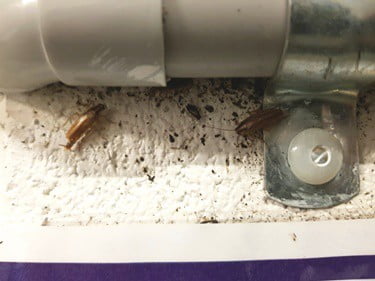
In Your Garage, Basement, Or Attic
Roaches prefer locales that don’t see much activity, so storage areas will be prime targets. Set traps near or around:
- Boxes
- Yard equipment
- Vehicles
- Decorations
- Trash cans
Where Do Cockroaches Hide Their Eggs?
Cockroaches reproduce rapidly. You may end up luring out and eliminating all the adults present in your house, only to have a new infestation hatch a few days or weeks later. It’s wise to place traps wherever the eggs are laid or as close by as you can. Then, when those new roaches hatch, they’ll walk right into your traps.
The good news is, roach eggs need the same ideal environment as adult cockroaches. Their hideouts will be warm, dark, moist, and isolated. Therefore, you will find egg cases in the following areas:
- Humid areas (bathrooms and kitchens, particularly near dishwashers or sinks)
- Behind wallpaper
- Tight crevices in your walls or ceilings
- Crawl spaces
- Furniture (couches, bedding, wooden tables, and chairs)
- Cardboard
- Near food sources (kitchens, pantries, fridges, garbage, and compost/food waste bins)
- Under pliable material (moist wood, bathroom or kitchen tile cracks, garbage or recycling piles)
Glue traps will be effective against roach nymphs. Place some around these danger zones and keep them refreshed for a couple of weeks. If you start finding baby roaches in the traps, you’ll know you’ve prevented a resurgence.
